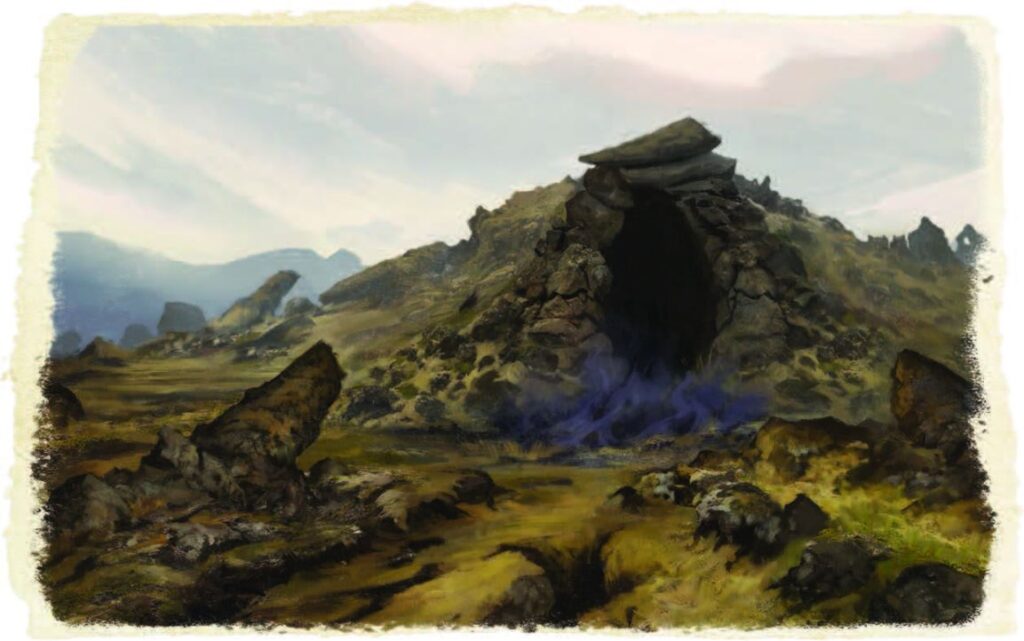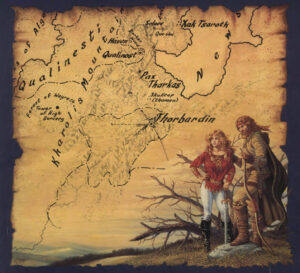
In Pathfinder and other role-playing games like Dungeons and Dragons, the movement rules provide a means for all characters to scramble up and down sheer surfaces to a limited extent but engaging in combat while suspended on these surfaces is another matter entirely. Characters who engage in melee or missile combat while on a sheer surface suffer penalties to combat abilities and have an increased chance of falling during the fight.
When climbing, a character loses all bonuses to his Armor Class that would come from a shield or Dexterity bonus. If the character's face is toward the surface, he presents his back to any attacker except one that is next to him on the wall, with the attendant penalties
Additionally, such a character can only face a foe to one side or the other. Since at least one hand is needed to hold on, the character cannot use multiple weapons. Finally, a -2 penalty is assessed to all of the character's attack, damage, and save rolls. If combatants are above or below their opponents during a fight on a wall, specific modifiers apply. The higher character gains a +2 "to hit" modifier in addition to all other modifiers that apply, while the lower character suffers a -2 modifier to his attack rolls.
If, in the DM's or GM's judgment, the character can reach a place of some security before engaging in combat, some or all of these penalties may be cancelled out. An archer who carefully selects a ledge from which he can easily see his targets and draw his bow should be able to fire normally. Likewise, a swordsman firmly balanced on a large boulder should have an advantage over opponents who are scrambling up to reach him.
Creatures defending a wall or cliff often roll or drop heavy objects onto attackers below. An average-sized boulder (three feet in diameter) inflicts 2d8 points of damage to anyone it strikes. All victims are treated as AC 10 for purposes of these attacks. If the creatures dropping the missile are unable to pick it up and hurl it (as a giant could), they suffer a -8 modifier to their attack roll. If the victims are climbing a sheer cliff, they could be knocked off by this attack, as given above.
Fighting on Bridges and Ledges
The situations covered in this section all assume that a character has enough room to stand somewhere without using his hands to hold on. This rule is applied if some sort of drop-off is located within five feet of the character. All of the difficulties associated with this type of combat relate to hits against the character; there are no penalties for attacking in this situation.
If a character gets hit by any attack that causes a loss of hit points or consciousness (such as a sleep spell), he must make a successful Dexterity Check to avoid falling over whatever drop off is nearby. The character's Dexterity, for purposes of this check, is increased by two for every foot of distance between the character's feet and the drop-off. The character's Dexterity should also be modified if the force of the blow pushes him toward or away from the drop-off.
In melee combat, a character with his back to a wall receives a +2 modifier to his Dexterity, while a character with his back to a drop-off receives a -2 penalty. During missile combat, the path of the missile serves as a good indicator of whether a character is pushed toward or away from a drop-off. For example, a character who is standing on a narrow bridge and is struck by an arrow fired from his left side will obviously be propelled toward the drop-off on his right. A character fighting on a ledge, on the other hand, with his back to the wall and his enemies before him, is pushed back toward the wall by the force of any blow. The modifier for such situations is a + or -2 to the character's Dexterity, applied in addition to all other modifiers.
Fighting in Water
Water interferes with the fighting effectiveness of characters and creatures not bred for that environment. If characters are standing in water that is less than waist deep, none of these combat penalties apply. If the water is waist deep to chest deep, the penalties are halved. If the characters are swimming or standing in water that rises higher than their chests, however, the penalties are fully in effect. Attacks by creatures not at home in water suffer a -4 penalty on the ld20 roll used to make the attack. If successful, such an attack suffers a -4 modifier to the amount of damage that it would normally inflict. Damage thus modified can be reduced to no less than 1 point. Any creature that spends part of its life in the water, or any character with swimming proficiency, is not penalized while fighting in the water.
Fighting in Narrow Passages
A common defensive barrier in caves is the bottleneck passage where only one or two characters can hold off a mob of attackers. This tactic limits the number of enemies that can attack at once. This bonus is of course usable by monsters and NPCs as well. It reflects the fact that a fighting individual can use such a location defensively, as protection from the enemy's attacks, or aggressively, as a means of striking the enemy at an advantage. The side claiming the bonus must have sufficient room for all fighting individuals to use their weapons without interfering with each other.
Narrow Passages: Strategic Combat in Dungeons & Dragons and Pathfinder
The strategic use of narrow passages, or "bottlenecks," in role-playing games such as Dungeons & Dragons (D&D) and Pathfinder can significantly influence the outcome of a battle. By manipulating the terrain, players and Dungeon Masters (DMs) can create compelling and tactically rich scenarios that challenge the strategic thinking of all participants. This article delves into the mechanics and implications of using narrow passages effectively in both D&D 5e and Pathfinder 2e, offering insights into how these scenarios can enhance the gameplay experience.
Understanding Bottleneck Tactics
A bottleneck is a narrow passage in a dungeon, cave, or any environment where movement is severely restricted. Such locations are strategically crucial because they limit the number of combatants who can engage in melee at any given time. This limitation can be a double-edged sword, advantageous to defenders and a potential trap for attackers.
Defensive Uses:
Defensively, bottlenecks serve as natural choke points that can protect a party from being overwhelmed by superior numbers. In both D&D and Pathfinder, characters defending a bottleneck can hold off numerous enemies, as only a few attackers can reach the defenders at a time. This scenario is particularly effective against mobs of weaker creatures that rely on swarming tactics.
In D&D 5e, characters can maximize their defensive position by using spells that control or manipulate the environment. Spells like web or spike growth can further reduce the effective width of a passage, enhancing the bottleneck's natural defensive benefits. Pathfinder 2e characters might employ similar tactics but can also take advantage of specific feats and class abilities that enhance their effectiveness in limited spaces, such as the Fighter's "Defensive Strategist" feat which boosts defense when remaining stationary.
Offensive Uses:
Offensively, controlling a bottleneck means forcing opponents to come to you, often breaking their formation and making them easier to manage and defeat. Clever players might lure enemies into narrow passages where ranged attackers and spellcasters can target the cramped foes with area-of-effect spells or abilities without fear of reprisal.
In Pathfinder 2e, certain spells and abilities are designed to exploit these scenarios. For example, the Wizard's narrow passage spell can temporarily create a bottleneck, forcing enemies to squeeze through a small space, thereby receiving penalties to their defense and attack capabilities.
Scenario Example: The Cave's Mouth
Imagine a scenario where a D&D party is exploring a cave system known to be infested with goblins. The party encounters a narrow tunnel that opens into a larger cavern. Anticipating a large number of enemies, the party's Paladin decides to hold the line at the tunnel entrance, using his shield and body to block the path, while the Wizard prepares an ice storm spell to cast into the cavern once the goblins approach.
In Pathfinder 2e, a similar setup could involve a Ranger setting traps at the bottleneck point, with a Sorcerer ready to cast wall of fire to control the battlefield. The Ranger's trap-setting capabilities combined with the Sorcerer's control spells can turn the tide of battle by funneling enemies into hazardous zones.
Tactical Considerations
While bottlenecks can provide significant tactical advantages, there are risks. Enemies might also use magic or special abilities to bypass or overcome the bottleneck. Spells like dimension door or abilities like the Pathfinder 2e Monk's abundant step can allow foes to appear behind the party's lines, turning their strategic advantage into a potential disaster.
Moreover, reliance on bottleneck tactics can become predictable. If an enemy force is aware of a party's dependence on such strategies, they might prepare countermeasures, such as collapsing the passage or using ranged attacks to flush out the defenders.
Integrating Bottleneck Tactics into Campaigns
For DMs, integrating bottleneck scenarios into campaigns requires thoughtful dungeon design and a keen understanding of party capabilities and enemy tactics. It's not just about creating narrow spaces but also about when and how these spaces appear in the narrative and their strategic relevance to the ongoing storyline.
By balancing the challenges and opportunities presented by narrow passages, DMs and players can enrich their gaming experience, making each encounter more than just a fight-it becomes a test of tactical acumen and strategic foresight.
There are many guidelines for combat in role-playing games like Dungeons & Dragons, Pathfinder, etc. so if there are any scenarios that are unclear, ask your Dungeon Master or Game Master for clarification.






